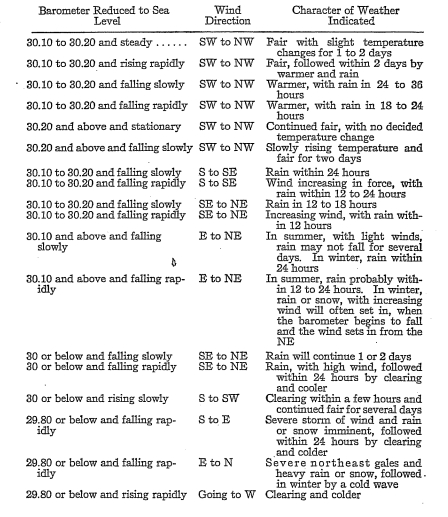 The
Science Notebook
The
Science NotebookGilbert Weather Bureau - Part IV
 The
Science Notebook
The
Science NotebookHome Terms of Use Safety Contact Us Experiment Pages Downloads Supplies Useful Links!





| Abilene, Tex. Albany, N.Y. Alphena, Mich. Amarillo, Tex. Anniston, Ala. Asheville, N.C. Atlanta, Ga. Atlantic City, N.J. Augusta, Ga. Baker, Ore. Baltimore, Md. Bentonville, Ark. Binghamton, N.Y. Birmingham, Ala. Bismarck, N.D. Block Island, R.I. Boise, Ida. Boston, Mass. Broken Arrow, Okla. Buffalo, N.Y. Burlington, Vt. Cairo, Ill. Canton, N.Y. Cape Henry, Va. Cape May, N.J. Charles City, Ia. Charleston, S.C. Charlotte, N.C. Chattanooga, Tenn. Cheyenne, Wyo. Chicago, Ill. Cincinnati, Ohio Clallam Bay, Wash. Cleveland, Ohio Columbia, Mo. Columbia, S.C. Columbus, Ohio Concord, N.H. Concordia, Kans. Corpus Christi, Tex. Dallas, Tex. Davenport, Ia. Dayton, Ohio Del Rio, Tex. Denver, Colo. Des Moine, Ia. Detroit, Mich. Devils Lake, No.Dak. Dodge City, Kans. |
Drexel, Neb. Dubuque, Ia. Duluth, Minn. Eastport, Me. Elkens, W. Va. Ellendale, No. Dak. El Paso, Tex. Erie, Pa. Escanaba, Mich. Eureka, Cal. Evansville, Ind. Fort Smith, Ark. Fort Wayne, Ind. Fort Worth, Tex. Fresno. Cal. Galveston, Tex. Grand Haven, Mich. Grand Junction, Colo. Grand Rapids, Mich. Green Bay, Wis. Greenville, S.C. Groesbeck, Tex. Hannibal, Mo. Harrisburg, Pa. Hartford, Conn. Hatteras, N.C. Havre, Mont. Helena, Mont. Honolulu, Hawaii Houghton, Mich. Houston, Tex. Huron, So. Dak. Independence, Cal. Indianapolis, Ind. Iola, Kans. Ithica, N.Y. Jacksonville, Fla. Juneau, Alaska Kalispell, Mont. Kansas City, Mo. Keokuk, Iowa Key West, Fla. Kilauea, Hawaii Knoxville, Tenn. La Crosse, Wis. Lander , Wyo. Lansing, Mich. Leesburg, Ga. Lewiston, Idaho |
| Lexington, Ky. Lincoln, Neb. Little Rock, Ark. Los Angeles, Cal. Louisville, Ky. Luddington, Mich. Lynchburg, Va. Macon, Ga. Madison, Wis. Manteo, N.C. Marquette, Mich. Memphis, Tenn. Meridian, Miss. Miami, Fla. Milwaukee, Wis. Minneapolis, Minn. Mobile, Ala. Modena, Utah Montgomery, Ala. Mount Tamalpais, Cal. Nantucket, Mass. Nashville, Tenn. Neah Bay, Wash. New Haven, Conn. New Orleans, La. New York, N.Y. Norfolk, Va. Northfield, Vt. North Head, Wash. North Platte, Neb. Oklahoma, Okla. Omaha, Neb. Oswego, N.Y. Palestine, Tex. Parkersburg, W. Va. Pensacola, Fla. Peoria, Ill. Philadelphia, Pa. Phoenix, Ariz. Pierre, So. Dak. Pittsburgh, Pa. Pocatello, Idaho Point Reyes Light, Cal. Port Angeles, Wash. Port Arthur, Tex. Port Huron, Mich. Portland, Me. Portland, Ore. Providence, R.I. |
Pueblo, Colo. Raleigh, N.C. Rapid City. So. Dak. Reading, Pa. Red Bluff, Cal. Reno, Nev. Richmond, Va. Rochester, N.Y. Roseburg, Ore. Roswell, New Mex. Royal Center, Ind. Sacramento, Cal. Saginaw, Mich. St. Joseph, Mo. St. Louis, Mo. St. Paul, Minn. Salt Lake City, Utah San Antonio, Tex. San Diego, Cal. Sand Key, Fla. Sandusky, Ohio Sandy Hook, N.J. San Francisco, Cal. San Jose, Cal. San Juan, Porto Rico San Luis Obispo, Cal. Santa Fe, New Mex. Sault Sainte Marie, Mich. Savannah, Ga. Scranton, Pa. Seattle, Wash. Sheridan, Wyo. Shreveport, La. Sioux City, Iowa Spokane, Wash. Springfield, Ill. Springfield, Mo. Syracuse, N.Y. Tacoma, Wash. Temple, Fla. Tatoosh Island, Wash. Taylor, Tex. Terre Haute, Ind. Thomasville, Ga. Toledo, Ohio Tonopah, Nev. Topeka, Kans. Trenton, N.J. |
| Twin, Wash. Valentine, Neb. Vicksburg, Miss. Wagon Wheel Gap, Colo. Walla Walla, Wash. Wichita, Kans. Williston, No. Dak. |
Wilmington, N.C. Winnemucca, Nev. Wytheville, Va. Yankton, So. Dak. Yellowstone Park, Wyo. Yuma, Ariz. |



